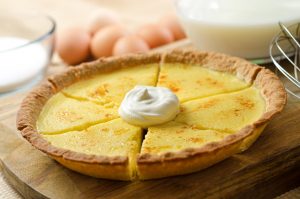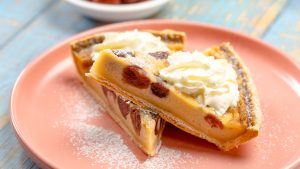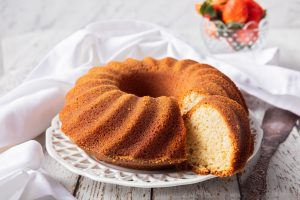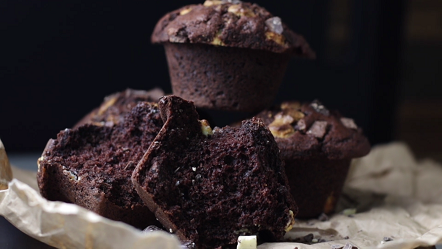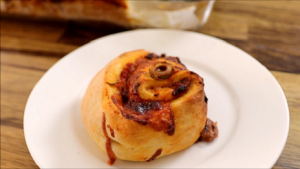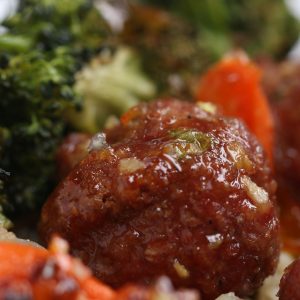Daryoles, better known as Medieval Custard Pie, is a delightful dessert that transports your taste buds back to the Middle Ages. This recipe combines simple ingredients to create an authentic custard pie that's rich with history and flavor.
Photos of Medieval Custard Pie (Daryoles) Recipe
One of the key ingredients in this recipe that you might not commonly find in your pantry is saffron powder. While it's a bit pricier than other spices, its unique flavor makes it well worth the cost. You may also be unfamiliar with rose water, a fragrant liquid often used in baking and cooking. Both these ingredients can be found in the spice or international section of most supermarkets.
Ingredients for the Medieval Custard Pie (Daryoles)
Pie crusts: These are the base of the pie. They can be homemade or store-bought.
Almonds: Used to make almond milk, which adds a nutty flavor to the custard.
Cold water: Used to make almond milk.
Half and half cream: This blend of cream and milk makes the custard rich and creamy.
Saffron powder: An expensive spice that gives the custard a distinctive flavor and color.
Ground cinnamon: Adds warmth and sweetness to the custard.
Eggs: These help to set the custard and give it structure.
White sugar: Sweetens the custard.
Rose water: Adds a subtle floral note to the custard.
One reader, Frieda Coates says:





This medieval custard pie recipe is a delightful throwback to the past. The blend of saffron and rose water adds an exotic touch, and the creamy texture is simply divine. It's a unique and delicious dessert that's perfect for a special occasion or just to indulge in a taste of history.
Key Techniques for Making Medieval Custard Pie
How to make almond milk: Grind almonds in a food processor, add water, and pulse to blend. Let the mixture sit for 10 minutes, then strain through a cheesecloth. Measure out 1 cup of almond milk.
How to thicken custard: Cook the custard mixture over low heat, stirring constantly until it thickens enough to coat the back of a metal spoon.
How to bake a custard pie: Bake the custard pie for 40 minutes in a preheated oven at 350 degrees Fahrenheit, or until the center is set but the top is not browned.
How To Make Medieval Custard Pie (Daryoles)
Have a sweet slice of this custard pie that brims with the flavor of homemade almond milk, spiced with cinnamon and saffron.
Serves:
Ingredients
- 29-inch pie crusts,unbaked
- ½cupalmonds,blanched
- 1¼cupscold water
- 1cuphalf and half cream
- 1pinchsaffron powder
- 1tspground cinnamon
- 5eggs
- ¾cupwhite sugar
- 1tsprose water
Instructions
-
Preheat the oven to 350 degrees F.
-
Press pie crusts into the bottom and up the sides of two 9 inch pie pans. Prick with a fork all over to keep them from bubbling up.
-
Bake pie crusts for about 10 minutes in the preheated oven, until set but not browned. Set aside to cool.
-
Make almond milk by placing almonds in the container of a food processor. Process until finely ground, then add water, and pulse just to blend.
-
Let the mixture sit for 10 minutes, then strain through a cheesecloth. Measure out 1 cup of almond milk, and mix with half and half. Stir in the saffron and cinnamon, and set aside.
-
Place the eggs and sugar in a saucepan, and mix until well blended. Place the pan over low heat, and gradually stir in the almond milk mixture and cinnamon.
-
Cook over low heat, stirring constantly until the mixture begins to thicken. When the mixture is thick enough to evenly coat the back of a metal spoon, stir in rose water and remove it from heat. Pour into the cooled pie shells.
-
Bake for 40 minutes in the preheated oven, or until the center is set, but the top is not browned.
-
Cool to room temperature, then refrigerate until serving.
Nutrition
- Calories: 173.65kcal
- Fat: 10.87g
- Saturated Fat: 4.51g
- Trans Fat: 0.00g
- Monounsaturated Fat: 4.28g
- Polyunsaturated Fat: 1.30g
- Carbohydrates: 17.07g
- Fiber: 0.77g
- Sugar: 6.68g
- Protein: 2.53g
- Cholesterol: 46.91mg
- Sodium: 95.15mg
- Calcium: 22.91mg
- Potassium: 56.19mg
- Iron: 0.48mg
- Vitamin A: 55.11µg
- Vitamin C: 0.07mg
Mastering the Art of Medieval Custard Pie: A Technique Tip
When making your medieval custard pie, it's crucial to slowly add the almond milk mixture into the eggs and sugar. This process, known as tempering, prevents the eggs from scrambling when they come into contact with the hot liquid. Always remember to stir constantly while adding the mixture to ensure a smooth and creamy custard.
Time-Saving Tips for Preparing Daryoles
Prep ahead: Prepare the pie crusts and almond milk mixture the day before to save time on the day of baking.
Use store-bought crusts: If you're short on time, consider using pre-made pie crusts to cut down on preparation time.
Multi-task: While the pie crusts are baking, you can start preparing the custard filling to maximize efficiency.
Set up your workspace: Organize your ingredients and tools before you start cooking to streamline the process and avoid any last-minute scrambling.
Follow the recipe: Stick to the instructions to ensure that you get the best results without having to make adjustments along the way.
Substitute Ingredients For Medieval Custard Pie (Daryoles) Recipe
pie crusts - Substitute with puff pastry sheets: Puff pastry can provide a flaky and buttery texture similar to traditional pie crusts, adding a delicious layer of richness to the daryoles.
almonds - Substitute with hazelnuts: Hazelnuts can offer a similar nutty flavor and crunchy texture, complementing the custard filling of the daryoles.
half and half cream - Substitute with whole milk and heavy cream: Combining whole milk and heavy cream can replicate the richness and creaminess of half and half, ensuring a luscious custard filling for the daryoles.
saffron powder - Substitute with turmeric powder: Turmeric can provide a similar golden hue and a subtle earthy flavor, mimicking the essence of saffron in the daryoles.
ground cinnamon - Substitute with nutmeg: Nutmeg can impart a warm and aromatic flavor, enhancing the spiced profile of the daryoles' custard filling.
eggs - Substitute with silken tofu: Silken tofu can serve as a vegan alternative, offering a creamy texture and binding properties similar to eggs in the custard filling of the daryoles.
white sugar - Substitute with honey: Honey can provide a natural sweetness and subtle floral notes, adding a unique flavor dimension to the daryoles' custard.
rose water - Substitute with orange blossom water: Orange blossom water can impart a delicate floral essence, enhancing the aromatic profile of the daryoles without overpowering the custard filling.
Presentation Tips for a Delightful Medieval Custard Pie
Elevate the pie crust: Gently crimp the edges of the pie crust for a polished look. Brush the edges with a touch of beaten egg for a golden finish.
Garnish with toasted almonds: Sprinkle toasted almond slices on top of the custard pie for a delightful crunch and visual appeal.
Drizzle with saffron-infused cream: Create an intricate design on the plate using saffron-infused cream to add a pop of color and a touch of elegance to the presentation.
Dust with edible gold leaf: For a luxurious touch, delicately place edible gold leaf on the custard pie to add a shimmering, regal effect.
Serve with a side of rose petals: Place a few fresh, edible rose petals on the plate to add a fragrant and visually stunning element to the presentation.
Accompany with a cinnamon stick: Garnish the plate with a cinnamon stick to add a hint of spice and a visually appealing element to the dish.
Sprinkle with powdered sugar: Lightly dust the custard pie with a fine layer of powdered sugar for a classic and elegant finishing touch.
Add a dollop of whipped cream: Place a small, carefully piped dollop of whipped cream on the side of the custard pie for a creamy and inviting addition to the presentation.
Essential Tools for Crafting the Perfect Daryoles
Food processor: A food processor is a versatile kitchen appliance that can be used for grinding almonds, making almond milk, and various other food processing tasks.
Pie pans: Pie pans are round, shallow baking dishes used to bake pies. They are typically made of metal or ceramic and come in various sizes.
Cheesecloth: Cheesecloth is a loose-woven gauze-like cotton cloth that is used for straining liquids and making almond milk in this recipe.
Saucepan: A saucepan is a deep cooking pan with a long handle and a lid, used for cooking custard and other mixtures over low heat.
Oven: The oven is used for baking the pie crusts and then baking the custard pie until set.
Mixing bowl: Mixing bowls are used for combining ingredients, such as mixing the eggs and sugar in this recipe.
Measuring cups and spoons: Measuring cups and spoons are used to accurately measure ingredients such as half and half cream, sugar, and rose water.
Whisk: A whisk is used for blending and mixing ingredients together, such as when combining the eggs and sugar in the saucepan.
Fork: A fork is used to prick the pie crusts before baking to prevent them from bubbling up.
Strainer: A strainer is used to strain the almond milk after processing the almonds and water in the food processor.
Metal spoon: A metal spoon is used to check the thickness of the custard mixture while cooking over low heat.
Preserving the Goodness: Storing and Freezing Daryoles
Allow the medieval custard pie to cool completely to room temperature before storing or freezing. This typically takes about 2-3 hours.
Once cooled, cover the pie tightly with plastic wrap or aluminum foil to prevent it from drying out or absorbing any odors from the refrigerator.
Refrigerator storage: Place the covered pie in the refrigerator and store for up to 3-4 days. The custard filling will remain smooth and creamy, and the pie crust will stay crisp.
Freezer storage: If you want to store the pie for a longer period, you can freeze it for up to 2 months. Wrap the cooled pie tightly with plastic wrap, then cover it with a layer of aluminum foil. Label the pie with the date and contents before placing it in the freezer.
To thaw a frozen medieval custard pie, transfer it from the freezer to the refrigerator and let it thaw overnight. Do not thaw the pie at room temperature, as this can cause the custard to become watery and the crust to become soggy.
Once thawed, remove the pie from the refrigerator about 30 minutes before serving to allow it to come to room temperature. This will enhance the flavors and textures of the custard and crust.
If you notice any signs of spoilage, such as mold growth or an off-odor, discard the pie immediately.
How To Reheat Leftover Medieval Custard Pie
Preheat your oven to 350°F (175°C). Place the leftover medieval custard pie on a baking sheet and cover it loosely with aluminum foil. This will help prevent the top from browning too quickly while the inside warms up. Bake for about 15-20 minutes, or until the custard is heated through and the crust is crisp.
For a quicker method, you can use the microwave. Cut the pie into individual slices and place them on a microwave-safe plate. Heat on high power for 30-45 seconds per slice, or until the custard is warm. Be careful not to overheat, as this can cause the custard to become rubbery.
If you want to crisp up the crust while reheating in the microwave, place the pie slice on a microwave-safe plate and heat for 30 seconds. Then, place the slice under the broiler for a minute or two, watching carefully to prevent burning.
For a stovetop method, cut the pie into slices and place them in a steamer basket over simmering water. Cover and steam for 5-7 minutes, or until the custard is heated through. This method helps maintain the creamy texture of the custard.
If you have an air fryer, you can reheat individual slices of medieval custard pie. Preheat the air fryer to 350°F (175°C) and place the slice in the basket. Cook for 3-5 minutes, or until the custard is warm and the crust is crisp.
Fascinating Facts About Medieval Custard Pie
The medieval custard pie, also known as daryoles, is a traditional English dish that dates back to the Middle Ages. It was a popular dessert during this time and was often served at feasts and banquets. The pie is made with a delicious almond custard filling flavored with saffron, cinnamon, and rose water, giving it a unique and aromatic taste. This historical recipe provides a glimpse into the culinary traditions of the past, showcasing the use of ingredients and flavors that were cherished during medieval times. The daryoles offer a delightful blend of sweet and nutty flavors, making them a delightful treat for any occasion.
Is Making Daryoles at Home Cost-Effective?
This medieval custard pie (daryoles) recipe is relatively cost-effective for a household. The use of basic ingredients like almonds, eggs, and sugar keeps the cost reasonable. The addition of saffron and rose water may slightly increase the cost, but these are used in small quantities. Overall Verdict: 8/10. Approximate cost for a household of 4 people: $10-$15.
Is Medieval Custard Pie (Daryoles) Healthy or Unhealthy?
This medieval custard pie recipe, while delicious, is not particularly healthy. The main concerns are:
- High in saturated fat due to the pie crusts and cream
- Significant amount of sugar
- Lacks fiber and essential nutrients
However, there are some redeeming qualities, such as the use of almonds, which provide healthy fats and protein, and the inclusion of saffron and cinnamon, which offer potential health benefits.
To make this recipe healthier, consider the following modifications:
- Use whole wheat or almond flour pie crusts to increase fiber and nutrients
- Replace half of the cream with low-fat milk or additional almond milk to reduce saturated fat
- Reduce the sugar content by using a natural sweetener like honey or maple syrup, or by simply using less sugar
- Incorporate more spices, such as nutmeg or cardamom, to enhance flavor without adding calories
- Serve the pie with fresh fruit to boost the overall nutrient content of the dessert
By making these adjustments, you can create a more balanced and nutritious version of this traditional custard pie while still maintaining its unique flavor profile. Experiment with different ingredients and ratios to find the perfect balance that satisfies your taste buds and your health goals.
Editor's Take on the Delightful Medieval Custard Pie Recipe
The medieval custard pie (daryoles) recipe is a delightful blend of flavors and textures. The combination of saffron, cinnamon, and rose water creates a rich and aromatic custard filling that is both comforting and exotic. The use of almond milk adds a unique nuttiness to the pie, elevating its overall taste. The recipe's simplicity and historical significance make it a charming addition to any culinary repertoire.
Enhance Your Medieval Custard Pie (Daryoles) Recipe with These Unique Side Dishes:
Discover Delightful Alternatives to Medieval Custard Pie
Appetizers and Main Dishes to Complement Your Medieval Custard Pie
Why trust this Medieval Custard Pie (Daryoles) Recipe:
This medieval custard pie (daryoles) recipe is a timeless classic, perfected over centuries. The use of saffron and rose water adds an exotic and aromatic touch, while the combination of almonds and cinnamon provides a rich and comforting flavor. The process of making homemade almond milk ensures a pure and wholesome base for the custard filling. With a careful balance of ingredients and a meticulous cooking method, this recipe promises a decadent and authentic medieval dessert experience.
Was this page helpful?
Have your own special recipe to share? Submit Your Recipe Today!
